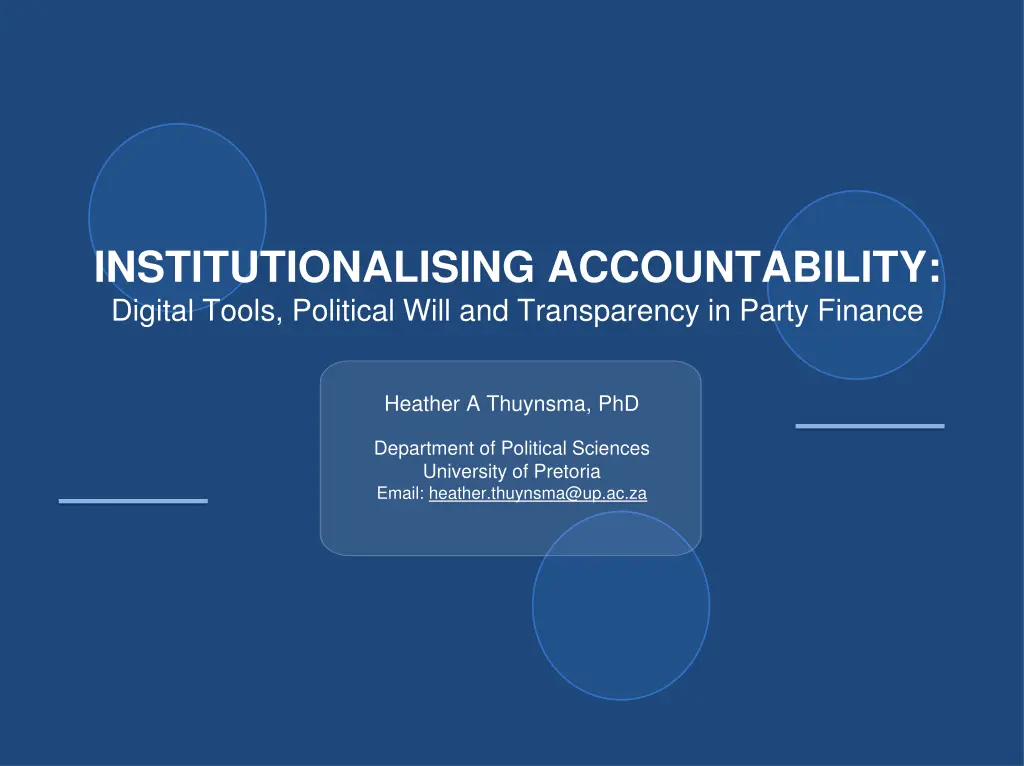
Enhancing Digital Transparency in Political Finance
Explore the framework for institutionalizing accountability through digital tools in political finance, assessing political will, compliance readiness, and implementation effectiveness. Discover strategic recommendations for sustaining regulatory enforcement and democratic trust in this insightful presentation.
Download Presentation

Please find below an Image/Link to download the presentation.
The content on the website is provided AS IS for your information and personal use only. It may not be sold, licensed, or shared on other websites without obtaining consent from the author. If you encounter any issues during the download, it is possible that the publisher has removed the file from their server.
You are allowed to download the files provided on this website for personal or commercial use, subject to the condition that they are used lawfully. All files are the property of their respective owners.
The content on the website is provided AS IS for your information and personal use only. It may not be sold, licensed, or shared on other websites without obtaining consent from the author.
E N D
Presentation Transcript
INSTITUTIONALISING ACCOUNTABILITY: Digital Tools, Political Will and Transparency in Party Finance Heather A Thuynsma, PhD Department of Political Sciences University of Pretoria Email: heather.thuynsma@up.ac.za
Presentation Objectives Define & Measure Political Will Develop frameworks for assessing commitment to digital transparency implementation Assess Compliance Willingness Evaluate party readiness to adopt digital transparency technologies Evaluate Implementation Effectiveness Measure success based on technological adoption & political commitment Strategic Recommendations Propose digital solutions to sustain regulatory enforcement & democratic trust
Digital Transparency in Democratic Context Global Democratic Challenges Digital Solutions Opportunity Declining institutional trust threatens legitimacy Real-time disclosure systems Populist movements challenge accountability Automated compliance monitoring Citizens demand real-time transparency Enhanced public access tools Blockchain audit trails Digital Transparency Real-time Trust Electoral Legitimacy Democratic Stability POLITICAL WILL REDEFINED Commitment to pursue digital reform despite technological and political resistance
Political Will Framework for Digital Implementation Individual Factors Organisational Factors Believe digital reform necessary Experience with transparency systems Risk vs technological benefits Digital institutional culture Technical administrative capacity Inter-agency coordination systems Relational Factors Technology Factors Trust in digital platforms Stakeholder technology networks Automated information flows User-friendly interfaces Automated validation systems Real-time processing capabilities
Digital Transparency Technologies Real-Time Disclosure Systems Estonia's X-Road Platform Distributed data exchange connecting government databases with real-time verification & blockchain audit trails Mobile Reporting Applications Brazil's DivulgaCand App OCR-enabled smartphone photography with automatic data extraction and database integration Integrated Compliance Platforms Mexico's Sistema Integral de Fiscalizaci n Java enterprise framework with banking integration and automated validation rules AI-Powered Anomaly Detection Czech Republic's ML Monitoring Machine learning algorithms identifying unusual donation patterns and compliance violations
Strategic Messaging for Digital Adoption Efficiency-First Approach "This digital system will reduce your campaign's administrative workload by 60% while ensuring automatic compliance validation." Defensive Benefits "Digital audit trails protect your campaign from false accusations while demonstrating financial integrity to voters." Competitive Advantage "Early transparency adoption positions your party as a reformer whilst building voter trust and credibility." Cost Reduction "Estonian parties report 65% administrative cost reductions and 78% fewer compliance violations after digital implementation."
Graduated Implementation Strategy Full Implementation o C mprehensive digital transparency system Voluntary Disclosure Demonstrate benefits before mandatory requirements Pilot Programs Low-stakes testing with local elections Technical Support Training and transition assistance Address Resistance Success Factors Customise requirements by campaign size Ensure equal application across parties Provide strategic disclosure timing Include independent oversight mechanisms Cross-party technical working groups Civil society partnerships Positive incentive programmes Capacity building support
South Africa: Implementation Crisis & Digital Opportunity 2024 Electoral Matters Amendment Bill Crisis Removed donation cap entirely Paused disclosure requirements PPFA rendered meaningless Institutional Memory Challenge Parties remember benefits of opacity: reduced scrutiny, unlimited funding, no public criticism of donor relationships Digital Solutions for SA Context Mobile-first platforms for accessibility Multi-language interfaces (11 official languages) Automated rand-amount tracking with inflation adjustments Integration with SARS and Companies House databases
Evidence of Adaptive Political Will May 2025 Parliamentary Resolution Upper Donation Limit: R30 million Disclosure Threshold: R200,000 Democratic Process Indicators Implementation Concerns Public consultation Higher limits reduce disclosure coverage Multi-stakeholder engagement Inflation adjustments weaken transparency Transparent deliberation Court pressure on timelines Evidence-based decisions Less frequent reporting requirements ASSESSMENT Negotiated political will balancing transparency with implementation realities
International Digital Implementation Examples Estonia - Comprehensive Digital Infrastructure X-Road + Blockchain + PostgreSQL APIs 65% administrative cost reduction, automatic verification, real-time cross-referencing Technology: Result: Colombia - Network Analysis & Graduated Disclosure Technology: Social network mapping + User-controlled visualisation Result: Relationship transparency without privacy violations, stakeholder buy-in Sweden - Proportional Digital Requirements Automated threshold calculations + Scaled reporting Fair burden distribution, small party protection, comprehensive coverage Technology: Result: Canada - Electronic Filing Evolution Modernisation messaging + Cross-party development Efficiency-focused adoption, reduced resistance, improved compliance Technology: Result:
Technology-Specific Party Messaging Blockchain Audit Trails "Cryptographic verification protects your campaign from false accusations whilst demonstrating unalterable financial integrity." Banking API Integration "Automatic bank integration eliminates 40% of compliance violations through perfect accuracy and real-time spending limit monitoring." AI Anomaly Detection "Artificial intelligence identifies errors and fraud attempts before they become public compliance issues, protecting your reputation." Mobile OCR Systems "Smartphone photograph technology reduces data entry from hours to seconds whilst maintaining perfect accuracy."
Sustaining Digital Reform Institutional Mechanisms & Incentive Alignment Enhance Technical Resources Strengthen Digital Institutions IEC digital capacity building Multi-stakeholder technology dialogue Party technical compliance support Evidence-based digital policy Civil society monitoring tools Independent technical oversight Long-term Digital Sustainability Adaptive Digital Framework Build transparency into party digital culture Regular technology reviews Demonstrate technology advantages Automated inflation adjustments Create positive feedback loops Continuous system improvements Digital Transparency + Automated Compliance + Real-time Enforcement = Democratic Legitimacy
Digital Implementation Roadmap Phase 1: Technology Demonstration (6 months) Pilot digital systems with willing parties, emphasise efficiency benefits, provide technical training Phase 2: Voluntary Digital Adoption (12 months) Expand successful pilots, offer positive incentives, build cross-party technical working groups Phase 3: Graduated Digital Requirements (18 months) Implement proportional digital disclosure based on campaign size and election type Phase 4: Comprehensive Digital Transparency (24 months) Full real-time system with automated compliance, AI monitoring, and public access tools SUCCESS METRICS Party adoption rates, compliance improvement, public trust indicators, administrative cost reduction
Research Implications & Measurement Longitudinal Digital Analysis Comparative Technology Studies Track real-time disclosure frequency Negotiated vs imposed digital reforms Measure digital compliance across parties Cross-national technology systems Monitor trust indicators pre/post digital reform Different digital enforcement mechanisms Digital Measurement Frameworks Develop "Negotiated Digital Will" Technology adoption indicators Technology acceptance baseline metrics Digital democratic legitimacy metrics International digital research partnerships Implementation effectiveness scales Evidence-based technology recommendations
Conclusions & Strategic Next Steps KEY FINDINGS Digital transparency tools can transform party resistance into voluntary adoption through strategic implementation and efficiency-focused messaging Successful Digital Strategies Immediate Actions Lead with efficiency, follow with transparency Pilot digital systems with willing parties Develop South Africa-specific mobile platforms Demonstrate protective rather than punitive benefits Create efficiency-focused messaging campaigns Provide graduated implementation pathways Establish technical support infrastructure Build cross-party technical coalitions Technology + Political Will + Strategic Implementation = Sustainable Democratic Transparency





















